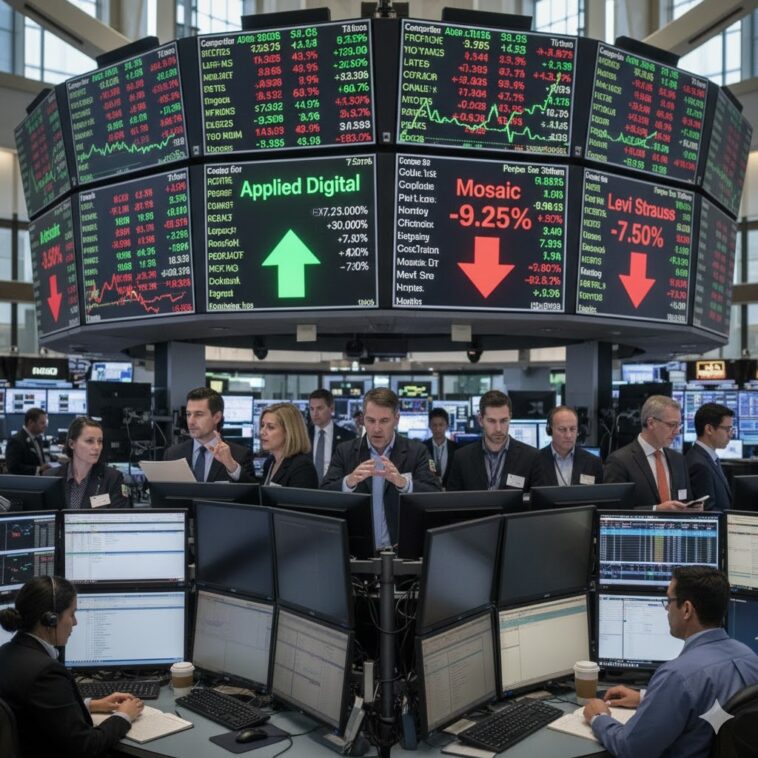It was a classic tale of two markets in the latest round of corporate earnings reports: a handful of high-flyers rocketed on strong growth, while established names were knocked down by operational hiccups and disappointing forecasts. The clear winner of the day was Applied Digital, the data center builder, whose shares surged an eye-watering 30% in early trading following a blockbuster fiscal first-quarter revenue report.
The $1.3 trillion digital infrastructure wave seems to have a new champion. Applied Digital’s revenue was up a staggering 84% from the same period last year. It’s a powerful sign that the demand for computing power, driven by everything from cloud services to artificial intelligence, remains insatiable.
The Winners’ Circle: Autos, Credit, and Data
While Applied Digital grabbed the headlines, other key sectors showed surprising resilience.
Stellantis, the behemoth Franco-Italian-American automaker, reported a solid 13% jump in third-quarter vehicle shipments. The bump, which helped push its shares up by 1.3% premarket, was largely attributed to a strong appetite for its newer models and—crucially—robust demand in the North American market. After what had been a rocky road of declining sales over several quarters, this jump acts as a powerful sign that management’s pivot toward fresh offerings is finally yielding results.
Meanwhile, Synchrony Financial, a key player in the consumer finance space, added 1% after HSBC upgraded the stock. “They are perfectly positioned to capture improving consumer credit quality without the regulatory baggage of the mega-banks,” noted Sarah Chen, Chief Market Strategist at Trident Asset Management. She called the stock a “preferred choice” within the volatile consumer lending environment.
Red Flags: China, Pharma Tech, and a Broken Pipe
For every Applied Digital out there, you can bet there’s a Mosaic or a Levi Strauss lurking nearby. The overall market is feeling the heat, with established players grappling with challenges that range from global economic shifts to just plain old mechanical hiccups.
Take Alibaba, the Chinese e-commerce behemoth, which took a nearly 2% dive, swept up in a broader sell-off that hit mainland Chinese and Hong Kong stocks overnight. This marks its sixth consecutive day in the red—a concerning trend that highlights growing investor jitters over regulatory crackdowns and a sluggish post-pandemic recovery in the world’s second-largest economy.
In the digital health arena, Doximity saw a 5% drop after JPMorgan decided to downgrade the medical platform from neutral to “underweight.” The Wall Street firm raised several warning flags: inflated valuations, a more competitive market, and perhaps most crucially, a tightening of ad budgets from pharmaceutical companies. “It’s a tough environment for niche ad platforms right now,” noted Michael Patel, an analyst at Horizon Research. “Big Pharma is getting picky about their spending, and Doximity’s high valuation just doesn’t account for enough potential risks.”
But the biggest letdown came from Mosaic, one of the largest fertilizer and chemical companies in the world. Its shares took a nosedive of over 9% after they reported dismal preliminary third-quarter volumes. What was to blame? Just some bad luck on the operational front. Management pointed to “unexpected mechanical issues” at their Riverview sulfuric acid plant and utility disruptions at the Bartow facility in mid-September. This led to a significant—and seemingly unavoidable—drop in overall production for the remainder of the month. It’s a stark reminder that even billion-dollar companies can be thrown off course by something as simple as a broken part.
The Denim Dilemma: Levi’s Guidance Gaps
Finally, the iconic denim maker Levi Strauss fell more than 7% after issuing fourth-quarter earnings guidance that landed well below Wall Street’s expectations. Levi’s now projects Q4 earnings per share in a range of $0.36 to $0.38. The consensus forecast, as tallied by FactSet, had been $0.41 per share. It’s a seemingly small gap, but one that speaks volumes about the firm’s difficulty in navigating both inventory glut and softening consumer discretionary spending. When even classic, durable denim can’t hit its targets, it raises uncomfortable questions about the American consumer’s willingness to spend heading into the crucial holiday season.
The Outlook
The current corporate earnings cycle underscores a growing divergence. We’re seeing capital flood into the clear, defensible growth stories—like the digital infrastructure championed by Applied Digital—while any sign of weakness, whether systemic (China) or idiosyncratic (Mosaic’s mechanical failure), is being punished swiftly and brutally. Investors are looking for execution and, right now, they’re not willing to pay a premium for promises.
As Chen of Trident Asset Management concluded, “The market has developed a zero-tolerance policy for missing guidance. The bar for success is high, but the penalty for failure is higher.”



